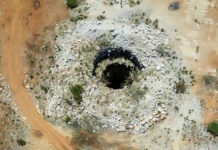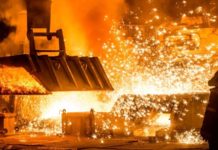[miningmx.com] — WHEN Uranium One CEO Neal Froneman said in April that, at $130/lb, the uranium price had run too far and could retreat for the first time in six years, he would hardly have wanted to be proved so right, so soon.
Since then the price has shed 30% – to $90/lb – and share prices have been as hard hit, compounded by apparent disappointment at recent reports from two leading South African uranium stocks.
If investors were put off by Uranium One’s reported quarterly loss of $13.7m, was that reaction justified? Under current accounting practices, losses are inescapable for any developing miner – and Uranium One is developing several mines, in Kazakhstan, South Africa, Australia and North America.
In fact, that loss of $13.7m was well down on the June 2006 quarter’s $32.2m, helped by a fine performance from its one operating asset, the 70%-owned Akdala mine in Kazakhstan, whose operating profit was $19.2m.
Moreover, sales contracts aren’t synchronised with production. In June, Uranium One only sold 244,000 lb of attributable production of 452,000 lb. That shortfall should be made up in coming quarters. In the March and December quarters, sales were well ahead of production.
Historical analysis of Uranium One’s results is virtually impossible, as it has been transformed this year by two major acquisitions: of UrAsia Energy (which owns Akdala) and Energy Metals, as well as buying significant assets from US Energy Corp.
The $225m Dominion project near Klerksdorp is coming into production; while the South Inkai and Karasan projects in Kazakstan should come on stream in the December quarter and early 2008, respectively. For 2007 as a whole, Uranium One is planning output of 2.5 million lbs, 1.8 million lbs of it from Akdala alone.
Comparing that to the June quarter’s attributable production of just 452,000 lbs it’s clear that, apart from Akdala, which is now operating at a steady rate, the other properties will start building up quite fast this year.
First Uranium’s market cap is only R7.3bn, against Uranium One’s R10.1bn and it’s only a local player. Moreover, unlike Uranium One, forex gains and net interest income (it raised C$150m in convertible debentures during the quarter) more than offset operating losses in the June quarter, allowing an overall profit of $5.5m.
It’s also still basically a gold miner, at the underground Ezulwini mine and the Buffelsfontein surface tailings operations. It doesn’t plan to negotiate any uranium sales contracts until mid-2008, when Ezulwini should reopen and start building up to production averaging 290,000 oz of gold and 888,000 lbs of uranium/year over an estimated 18-year life.
CEO Gordon Miller believes that, following the debenture issue and with $275m cash on hand at 30 June, it has enough financial resources to complete its development plans by 2010.
After hovering around $10 for at least 15 years, during a long period of oversupply in which more than half total demand was satisfied by running down stockpiles, the uranium price broke above $20/lb only in late 2004. So it’s understandable that, just three years later, $130/lb proved unsustainable.
However, the chronic oversupply has started to go into reverse, as it’s more widely realised that – contrary to general belief – nuclear-generated electricity is environmentally friendly. Between 130 and 160 nuclear power plants are being planned or are under construction, on top of the 440 already operating. That should ensure strong long-term growth in demand for new mine output.
First Uranium bases its development plans on a price of $60/lb; Uranium One is a little more conservative at $50/lb. So both should be extremely profitable even if the uranium price eases further, while in the short run at First Uranium any decline in price received should be more than offset by sales more closely in line with production.
No doubt uranium share prices were unrealistically hyped up earlier this year, and any major recovery may not happen until the steadying in the metal price is accepted as more than a dead-cat bounce.











